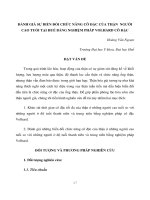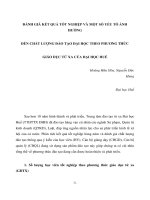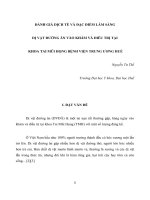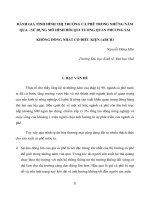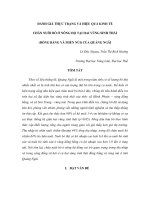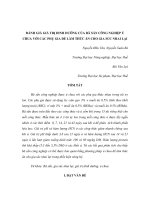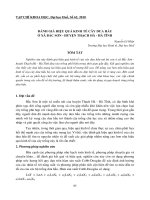Báo cáo nghiên cứu khoa học: "Đánh giá hiệu quả chi phí can thiệp để giảm bớt gánh nặng thiệt hại liên quan đến lạm dụng rượu: ace rượu" potx
Bạn đang xem bản rút gọn của tài liệu. Xem và tải ngay bản đầy đủ của tài liệu tại đây (27.55 KB, 5 trang )
79
JOURNAL OF SCIENCE, Hue University, N
0
61, 2010
ASSESSING COST-EFFECTIVE INTERVENTIONS TO REDUCE THE
BURDEN OF HARM ASSOCIATED WITH ALCOHOL MISUSE: ACE
ALCOHOL
Christopher Doran
National Drug and Alcohol Research Centre, University of New South Wales
Theo Vos, Linda Cobiac, Wayne Hall, Isaac Asamoah, Angela Wallace
Shamesh Naidoo, Joshua Byrnes, Greg Fowler, Kathryn Arnett
School of Population Health, University of Queensland
SUMMARY
Introduction: Alcohol is an important risk factor for disease and injury. A number of
strategies are available for both treating and preventing alcohol-related harm. The purpose of
the presentation will be to discuss the results of the recently completed cost-effectiveness
analysis of interventions to reduce the burden of harm associated with alcohol misuse in
Australia (ACE-Alcohol). Methods: Cost-effectiveness analysis is based on one-off intervention
in the first year, with all costs and health outcomes evaluated over the lifetime of the target
group in the Australian population in the baseline year of 2003. The health outcomes are
evaluated in disability-adjusted life years (DALYs), using a multi-state, multiple cohort life-
table approach to determine changes in mortality and morbidity of alcohol-related diseases and
injuries. Cost offsets are evaluated from the number of incident or prevalent cases of disease or
injury averted. Results: The results suggest that there is large variability in the health gains that
can be achieved with different methods of intervention. With the exception of increasing the
minimum legal drinking age to age 21, which benefits only those aged between 18 and 20 years,
the interventions that target hazardous and harmful drinkers (brief intervention ± telemarketing
and support) or alcohol dependents (residential treatment ± naltrexone) avert fewer DALYs than
the population-wide interventions. When combined as a package, the alcohol interventions
could avert 26,000 DALYs at a total intervention cost of $210 million. The costs of intervention
would be partly offset by an estimated reduction of $130 million in the costs of treating alcohol-
related diseases and injuries. Conclusions: Intervention to encourage more responsible
consumption of alcohol is recommended. Due to potential reductions in the costs of treating
alcohol-related diseases and injuries, there is substantial potential for health gain at a relatively
low cost, from a health sector perspective.
Keywords: alcohol misuse, cost-effective, ACE, intervention.
80
1. Introduction
The National Drug Strategy household survey from 1993 to 2004 shows that
four in five Australians drank alcohol in the past year and one in ten did so daily.
Although the evidence suggests that most Australians consume alcohol with an average
pattern of drinking at low risk levels, substantial numbers of both low risk drinkers and
higher risk drinkers also drink above the limits for acute harm. Although the
relationship between alcohol consumption and health is complex, the evidence is
irrefutable, the misuse of alcohol represents one of the leading causes of preventable
death, illness and injury in Australia. Alcohol is the single most important risk factor for
both fatal and non-fatal injuries and in 2004-05, the total tangible cost attributed to
alcohol consumption (which includes lost productivity, health care costs, road accident-
related costs and crime-related costs) was estimated at $10.83 billion. A number of
strategies are available to governments to minimise the harm associated with alcohol
misuse. Considerable research has been conducted into understanding whether various
interventions for problem drinkers work. While evidence on effectiveness is important,
policy makers require additional information on the efficiency of interventions, i.e., an
assessment of both costs and consequences. As an aid to priority setting, several studies
have examined efficiency using cost-effectiveness analysis.
The purpose of this study is to provide a comprehensive analysis of the cost-
effectiveness of interventions to reduce the burden of harm associated with alcohol
misuse in Australia. The project has been labelled ACE-Alcohol as it aims to Assess the
Cost-Effectiveness (ACE) of interventions to reduce Alcohol related harm. The research
contextualises results from a recent World Health Organisation study to the Australian
setting using, where possible, Australian data on costs, effectiveness of interventions
and health outcomes.
2. Methodology
ACE-Alcohol builds on a broader body of priority setting research that explicitly
focuses on cost-effectiveness analysis. The ACE-Alcohol model is built in Microsoft
Office Excel 2003 and uses the add-in tool. Risk for uncertainty analysis. Intervention
cost-effectiveness was evaluated over the lifetime of the Australian population eligible
for each intervention in a baseline year of 2003. The modelling strategy adopts two
approaches according to whether diseases or injuries related to alcohol misuse are
evaluated.
A technical advisory panel comprised of alcohol experts assisted in the
identification of interventions modelled in ACE-Alcohol. The interventions evaluated
include: volumetric taxation; advertising controls; mass media campaigns; brief
intervention by primary care practitioners; provision of residential treatment to
individuals with alcohol dependence; licensing controls; increasing the minimum legal
81
drinking age to 21 years; and, random breath testing (RBT).
In the cost-effectiveness analysis, all intervention costs, cost offsets and DALYs
were adjusted to the baseline year of 2003 and discounted at a rate of 3% per annum. An
incremental cost-effectiveness ratio (ICER) was evaluated for each intervention and
compared with a cost-effectiveness threshold of $50,000 per DALY averted. Two
comparators were used in ACE-Alcohol: current practice and the partial null. Current
practice was considered to comprise predominantly on RBT given its widespread use
throughout Australia. Using the partial null, interventions were also assessed using
marginal analysis. This enables increasing amounts of investment in the chosen
intervention to be compared with the additional benefits conferred. Such an analysis
lends itself to identifying an optimal expansion pathway, i.e., the ordering of
interventions in the most efficient package.
3. Results and Discussion
The findings of ACE-Alcohol suggest the health gains that can be achieved,
measured by DALYs, range from 150 (95% uncertainty interval (UI): 79 – 260) for
increasing the minimum legal drinking age to 11,000 (95%UI: 6,000 – 16,000) for
taxation. With the exception of increasing the minimum legal drinking age to age 21,
which benefits only those aged between 18 and 20 years, the interventions that target
hazardous and harmful drinkers (brief intervention with/without support) or alcohol
dependents (residential treatment with / without naltrexone) avert fewer DALYs than
the population-wide interventions. There is also substantial variability in the
intervention costs. These range from $0.58 million (95%UI: $0.47 million – $0.69
million) for taxation increases to $71 million (95%UI: $57 million – $85 million) for
random breath testing.
Two interventions stand out as being most effective and cost-effective: changes
to the way taxes are imposed and advertising bans. Both of these interventions are
dominant (i.e., less expensive and more effective than current practice) and have a high
probability of being cost-effective. Increasing the minimum legal drinking age to 21
years is also dominant, although the potential health gains are small given the target
range is persons aged 18 – 20 years. All other interventions have a high or very high
probability of being under the $50,000 per DALY cost-effectiveness threshold. The
exception is residential treatment for alcohol dependence (with or without naltrexone)
which is not cost-effective.
In terms of the most cost-effective package of interventions, the expansion path
includes (in order of incremental cost-effectiveness): volumetric taxation, advertising
bans, increase in minimum legal drinking age to 21 years, brief intervention, licensing
controls, drink driving mass media campaign, random breath testing and then residential
treatment + naltrexone. When combined as a package, the alcohol interventions could
82
avert 26,000 DALYs (95%UI: 19,000 – 34,000 DALYs) at a total intervention cost of
$210 million (95%UI: $190 million – $230 million). The costs of intervention would be
partly offset by an estimated reduction of $130 million (95%UI: $64 million – $220
million) in the costs of treating alcohol-related diseases and injuries.
The key findings from ACE-Alcohol suggest that all the prevention
interventions modelled are more cost-effective in reducing alcohol-related harm than
those that treat alcohol dependence. When taken as a package of interventions, all
interventions modelled with the exception of residential treatment would result in a
cost-effective investment portfolio. Compared to current practice, the optimal package
could lead to a substantial improvement in population health at a cost of under $50,000
per DALY. Changes to volumetric taxation and banning of alcohol advertising should be
a high priority for investment due to the high probability of cost-savings. Increasing the
minimum legal drinking age to 21 years, brief interventions in general practice,
increased licensing controls, drink driving campaigns and random breath testing are also
likely to be cost-effective when judged against a $50,000 per DALY threshold. Only
residential treatment for alcohol dependence (with or without naltrexone) is not cost-
effective by this standard.
The results suggest that although random breath testing is cost-effective and is
already being implemented in Australia, the same amount of $71 million that is
currently spent on random breath testing would, if invested in more cost-effective
interventions, achieve over ten times the amount of health gain.
4. Conclusion
In spite of the shortcomings of ACE-Alcohol, the results provide policy makers
with clear evidence on the cost-effectiveness of interventions to curb alcohol misuse. By
re-allocating existing resources committed to reducing alcohol-related harm, policy
makers could achieve over ten times the health gain for the same level of investment.
Given the scarcity of resources and the ever-increasing fiscal restraint imposed by
governments, it is hoped that these results may be adopted by policy makers in order to
reduce the current burden of harm that alcohol imposes on our society.
REFERENCES
1. Australian Institute of Health and Welfare (AIHW). 2004 National Drug Strategy
Household Survey. Canberra: AIHW; 2005.
2. Collins D., Lapsley H. The Avoidable Costs of Alcohol Abuse in Australia and the
Potential Benefits of Effective Policies to Reduce the Social Costs of Alcohol. Canberra:
Commonwealth of Australia; 2008.
83
3. Collins D., Lapsley H. The Costs of Tobacco, Alcohol and Illicit Drug Abuse to
Australian Society in 2004–2005. Canberra: Commonwealth of Australia; 2008.
4. Room R., Babor T., Rehm J. Alcohol and public health. Lancet 2005; 365: 519–30.
5. McCrady B., Longabaugh R., Fink E., Stout R., Beattie M., Ruggieriauthelet A. Cost-
effectiveness of alcoholism treatment in partial hospital versus inpatient settings after
brief inpatient treatment—12-month outcomes. J Consult Clin Psychol 1986; 54: 708–
13.
6. Schadlich P. K., Brecht J. G. The cost effectiveness of acamprosate in the treatment of
alcoholism in Germany: economic evaluation of the prevention of relapse with
acamprosate in the management of alcoholism (PRAMA) study. Pharmacoeconomics
1998; 13: 719–30.
7. Palmer A. J., Neeser K.,Weiss C., Brandt A., Comte S., FoxM. The long-termcost-
effectiveness of improving alcohol abstinence with adjuvant acamprosate. Alcohol
Alcohol 2000; 35: 478–92.
8. Wutzke S. E., Shiell A., Gomel M. K., Conigrave K. M. Cost effectiveness of brief
interventions for reducing alcohol consumption. Soc Sci Med 2001; 52: 863–70.
9. Corry J., Sanderson K., Issakidis C., Andrews G., Lapsley H. Evidence-based care for
alcohol use disorders is affordable. J Stud Alcohol 2004; 65: 521–9.
